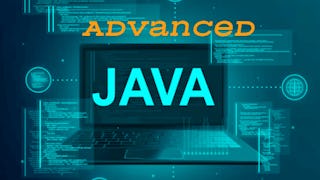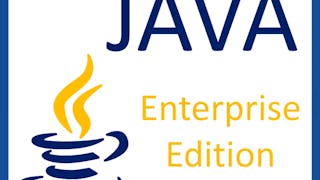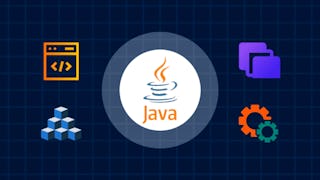This comprehensive course equips learners with the skills to design, develop, and manage dynamic web applications using Java Servlets and JDBC integration within the Java EE framework. Through a structured and hands-on approach, learners begin by exploring the core principles of servlet architecture, HTTP request handling, and server setup using Tomcat. As the course progresses, they will implement servlet lifecycle methods, configure initialization parameters, and construct scalable applications using the MVC pattern.



Empfohlene Erfahrung
Kompetenzen, die Sie erwerben
- Kategorie: Middleware
- Kategorie: Web Applications
- Kategorie: Application Servers
- Kategorie: Web Servers
- Kategorie: Relational Databases
- Kategorie: Data Access
- Kategorie: Java Platform Enterprise Edition (J2EE)
- Kategorie: Authentications
- Kategorie: Back-End Web Development
- Kategorie: Software Design Patterns
- Kategorie: Java
- Kategorie: Apache Tomcat
- Kategorie: SQL
- Kategorie: Model View Controller
- Kategorie: Stored Procedure
- Kategorie: Data Validation
- Kategorie: Databases
- Kategorie: Secure Coding
- Kategorie: Server Side
Wichtige Details

Zu Ihrem LinkedIn-Profil hinzufügen
Juli 2025
28 Aufgaben
Erfahren Sie, wie Mitarbeiter führender Unternehmen gefragte Kompetenzen erwerben.

In diesem Kurs gibt es 8 Module
This module introduces the foundational concepts of Java EE (J2EE) and the role of servlets in web applications. Learners will gain a practical understanding of servlet architecture, how to set up the environment using Tomcat, and implement basic servlet functionality through lifecycle methods and HTTP request handling. It builds the core knowledge required to develop and deploy servlet-based applications in a Java EE environment.
Das ist alles enthalten
8 Videos4 Aufgaben
This module explores the use of servlet configuration and context objects, enabling learners to manage shared application data and initialization parameters. The lessons focus on differentiating between ServletConfig and ServletContext, understanding their practical use cases, and configuring servlet behavior through load-on-startup mechanisms. This sets the stage for building efficient, state-aware web applications.
Das ist alles enthalten
5 Videos3 Aufgaben
This module introduces the Model-View-Controller (MVC) architectural pattern within the context of Java Servlets. Learners will explore how to separate concerns in web application development, implement request dispatching using RequestDispatcher, and understand how forwarding and redirection operate within servlet-based architectures. Through practical code examples and guided explanation, this module emphasizes clean design and control flow in servlet applications.
Das ist alles enthalten
10 Videos4 Aufgaben
This module focuses on preserving user data across multiple interactions with a web application. Learners will explore the core techniques of session tracking in Java Servlets, including cookies, hidden fields, and URL rewriting. The lessons provide hands-on exposure to maintaining state in stateless HTTP environments, helping learners build more interactive and user-aware applications.
Das ist alles enthalten
7 Videos4 Aufgaben
This module extends session tracking by focusing on HTTP session objects and cookie-based authentication mechanisms. Learners will learn how to implement login/logout functionality using both session and cookie strategies. By building end-to-end examples, this module helps consolidate skills in user session control, secure access, and lifecycle handling of web interactions.
Das ist alles enthalten
7 Videos3 Aufgaben
This module introduces learners to database fundamentals and SQL operations in the context of Java web development. It begins with a foundational overview of relational databases and continues through practical SQL syntax, covering commands for data manipulation, definition, and constraint enforcement. Learners will understand how to prepare data environments for backend integration with servlet-based applications.
Das ist alles enthalten
14 Videos4 Aufgaben
This module bridges Java web applications with backend databases using JDBC (Java Database Connectivity). Learners will explore how to establish connections, perform CRUD operations, and securely interact with database systems through servlets. The lessons emphasize JDBC classes and interfaces, as well as best practices for real-world data handling.
Das ist alles enthalten
6 Videos3 Aufgaben
Das ist alles enthalten
6 Videos3 Aufgaben
Erwerben Sie ein Karrierezertifikat.
Fügen Sie dieses Zeugnis Ihrem LinkedIn-Profil, Lebenslauf oder CV hinzu. Teilen Sie sie in Social Media und in Ihrer Leistungsbeurteilung.
Mehr von Software Development entdecken
 Status: Vorschau
Status: VorschauLearnKartS
 Status: Kostenloser Testzeitraum
Status: Kostenloser TestzeitraumLearnQuest
 Status: Kostenloser Testzeitraum
Status: Kostenloser TestzeitraumBoard Infinity
 Status: Kostenloser Testzeitraum
Status: Kostenloser Testzeitraum
Warum entscheiden sich Menschen für Coursera für ihre Karriere?





Neue Karrieremöglichkeiten mit Coursera Plus
Unbegrenzter Zugang zu 10,000+ Weltklasse-Kursen, praktischen Projekten und berufsqualifizierenden Zertifikatsprogrammen - alles in Ihrem Abonnement enthalten
Bringen Sie Ihre Karriere mit einem Online-Abschluss voran.
Erwerben Sie einen Abschluss von erstklassigen Universitäten – 100 % online
Schließen Sie sich mehr als 3.400 Unternehmen in aller Welt an, die sich für Coursera for Business entschieden haben.
Schulen Sie Ihre Mitarbeiter*innen, um sich in der digitalen Wirtschaft zu behaupten.
Häufig gestellte Fragen
Access to lectures and assignments depends on your type of enrollment. If you take a course in audit mode, you will be able to see most course materials for free. To access graded assignments and to earn a Certificate, you will need to purchase the Certificate experience, during or after your audit. If you don't see the audit option:
The course may not offer an audit option. You can try a Free Trial instead, or apply for Financial Aid.
The course may offer 'Full Course, No Certificate' instead. This option lets you see all course materials, submit required assessments, and get a final grade. This also means that you will not be able to purchase a Certificate experience.
When you purchase a Certificate you get access to all course materials, including graded assignments. Upon completing the course, your electronic Certificate will be added to your Accomplishments page - from there, you can print your Certificate or add it to your LinkedIn profile. If you only want to read and view the course content, you can audit the course for free.
You will be eligible for a full refund until two weeks after your payment date, or (for courses that have just launched) until two weeks after the first session of the course begins, whichever is later. You cannot receive a refund once you’ve earned a Course Certificate, even if you complete the course within the two-week refund period. See our full refund policy.
Weitere Fragen
Finanzielle Unterstützung verfügbar,

 enthalten
enthalten
